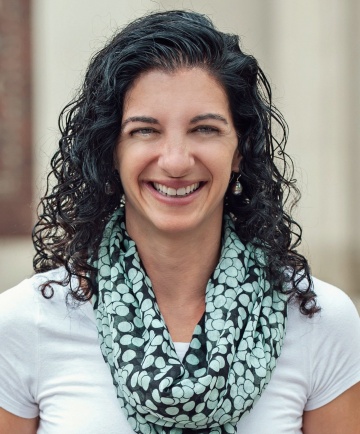Columbia College | Columbia University in the City of New York
Take Five with Kirsten Fermaglich ’92

What were you like when you arrived at Columbia?
Nerdy would be a kind way to describe it. I had frizzy hair, bangs and a unibrow; I wore clothes that were several sizes too big. And I was so embarrassingly sheltered. Honestly, I can’t answer this question without shuddering.
What do you remember about your first-year living situation?
My suitemates on the 13th floor of Carman were lovely, and definitely lightyears ahead of me in coolness. They were nice but we weren’t really friends, and indeed, I really didn’t make friends with anyone on my floor.
But I do remember our incredible view of the river and the George Washington Bridge — that was amazing and always made me feel special.
What Core class or experience do you most remember, and why?
I would have to say Art Hum, first semester freshman year. Our instructor was a grad student named Lisa Kapstein; she was wonderful, warm and energetic, and she encouraged me not to be intimidated by art. Art Hum was the first place where I saw art as something you could put into a context, criticize and interpret. I remember going to the Museum of Modern Art and analyzing an Anselm Kiefer exhibition. I felt like I’d been given a key to the city, to be able to travel by subway by myself; but even more, to go to a famous museum, see the work of a famous artist and to have the tools to analyze that work and that museum. It was power.
Did you have a favorite spot on campus, and what did you like about it?
I can’t actually believe I’m saying this, but it was definitely the dingy Amsterdam Avenue offices of Spectator in the 1980s–1990s. I’m sure it’s in part because I spent so much damn time there — I really didn’t have any time to hang out anywhere else. But of course, it was really because Spec was where my friends were, where we ordered Szechuan noodles and ate Ben & Jerry’s ice cream and watched Beverly Hills 90210 and stayed up until 3 a.m. and partied and started romances and stopped romances and started new ones. It was our space — much more than the dorms or the library or the Steps. It was where I learned to write, where I learned to think critically and where I learned to have fun.
What, if anything, about your College experience would you do over?
I thought that I’d answer this question by saying that I would have worked harder at my classes. I would have gone to my professor’s office hours more (especially now that I have seen those sad, lonely office hours from the other end). I would have taken more time to read, to think and to grow intellectually.
But rereading my answers to all of these questions, it’s pretty clear that I would not have done anything very differently at all. Columbia gave me what I needed at that time of life. I’ve had the rest of my life to read, to think and to grow intellectually, but I will never again have the chance to eat Koronet pizza on a dirty, ripped-up couch while reading a new reporter’s article and figuring out how to make it better, laughing with friends the entire time.
More “Take Five”
- 1 of 32
- ›

